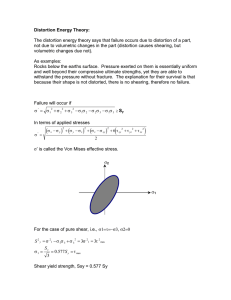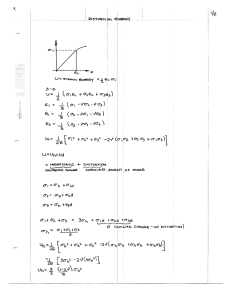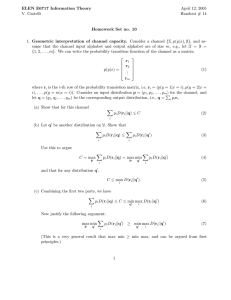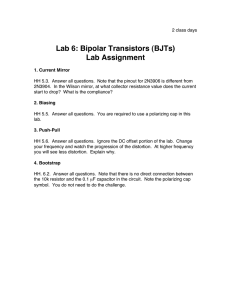XI. MODULATION THEORY AND SYSTEMS
advertisement
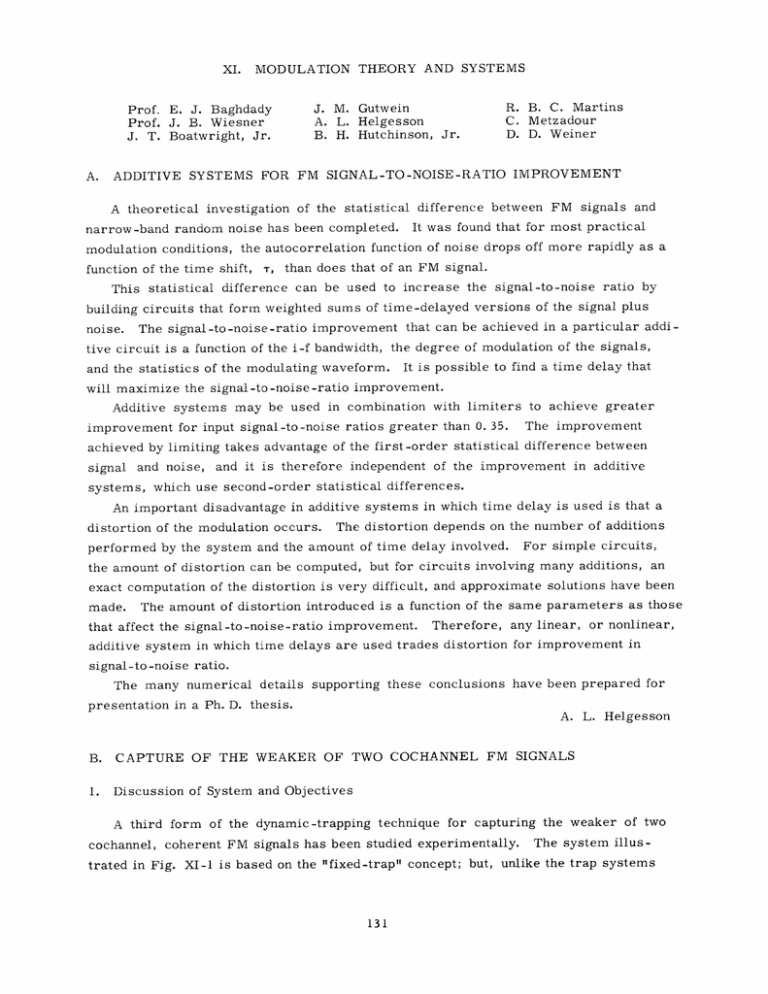
XI. MODULATION THEORY AND SYSTEMS J. M. Gutwein A. L. Helgesson B. H. Hutchinson, Jr. Prof. E. J. Baghdady Prof. J. B. Wiesner J. T. Boatwright, Jr. A. R. B. C. Martins C. Metzadour D. D. Weiner ADDITIVE SYSTEMS FOR FM SIGNAL-TO-NOISE-RATIO IMPROVEMENT A theoretical investigation of the statistical difference between FM signals and narrow-band random noise has been completed. It was found that for most practical modulation conditions, the autocorrelation function of noise drops off more rapidly as a function of the time shift, T, than does that of an FM signal. This statistical difference can be used to increase the signal-to-noise ratio by building circuits that form weighted sums of time-delayed versions of the signal plus noise. The signal-to-noise-ratio improvement that can be achieved in a particular addi- tive circuit is a function of the i-f bandwidth, the degree of modulation of the signals, and the statistics of the modulating waveform. It is possible to find a time delay that will maximize the signal-to-noise-ratio improvement. Additive systems may be used in combination with limiters to achieve greater The improvement improvement for input signal-to-noise ratios greater than 0. 35. achieved by limiting takes advantage of the first-order statistical difference between signal and noise, and it is therefore independent of the improvement in additive systems, which use second-order statistical differences. An important disadvantage in additive systems in which time delay is used is that a distortion of the modulation occurs. The distortion depends on the number of additions For simple circuits, performed by the system and the amount of time delay involved. the amount of distortion can be computed, but for circuits involving many additions, an exact computation of the distortion is very difficult, and approximate solutions have been made. The amount of distortion introduced is a function of the same parameters as those that affect the signal-to-noise-ratio improvement. Therefore, any linear, or nonlinear, additive system in which time delays are used trades distortion for improvement in signal-to-noise ratio. The many numerical details supporting these conclusions have been prepared for presentation in a Ph. D. thesis. A. L. B. CAPTURE OF THE WEAKER OF TWO COCHANNEL FM SIGNALS 1. Discussion of System and Objectives Helgesson A third form of the dynamic -trapping technique for capturing the weaker of two cochannel, coherent FM signals has been studied experimentally. The system illus- trated in Fig. XI-I is based on the "fixed-trap" concept; but, unlike the trap systems 131 (XI. MODULATION THEORY AND SYSTEMS) E EQUALIZER INPUT I E MXWITH MIXER FIXED TUNED TRAP AT CENTER OF BAND MIXER CONVERTER N UUNVENiIUNAL FM DEMODULATOR AF OUTPUT AMPLIFIER LOCAL OSCILLATOR (FREQUENCY,wo) WEAKERSIGNAL SUPPRESSOR Fig. XI-1. Fixed-trap system that does not require predetection of the stronger signal. investigated previously (1, 2, 3), it does not require prior demodulation of the stronger (undesired) signal. This avoids the necessity of providing for more than one demodu- lator or for critical circuits such as time-variant filters, or a time-variant (modulated) local oscillator. The operation of the system may be described as follows. i-f amplifier is split into two unilateral independent channels. tains a delay equalizer whose function is described below. The output of the The upper channel con- The lower channel contains a weaker-signal suppressor (a cascaded section of narrow-band limiters with, or without, feedforward). This device performs the preliminary operation of suppressing the amplitude of the weaker (desired) signal with respect to the stronger (undesired) signal. Assume for the moment that this device is able to achieve complete weaker-signal suppression so that in the output of this suppressor we have essentially the stronger signal. This stronger signal is heterodyned with a local oscillator whose frequency, at the center frequency of the bandpass trap filter in the upper channel. wo, is fixed The output of this stage of conversion after filtering, econv(t), consists essentially of the stronger FM signal whose spectrum has been linearly translated to a new i-f frequency, el - o" It is important to note what this suppression-conversion operation accomplishes. It produces a third FM signal, econv(t), whose instantaneous frequency differs from the instantaneous frequency of the stronger signal in the output of the delay network by a constant that equals the fixed center frequency of the trap (or the local-oscillator frequency). The signal econv(t) drives two mixing stages. of two signals. The output of the first stage consists One is a constant-frequency signal whose frequency coincides with the center frequency of the trap attenuation band. The other signal has the same center frequency but is frequency-modulated by the algebraic sum of the modulations of both the weaker and stronger signals. The second mixing operation restores the original frequency modulation to the signals modified by the trap. The output of the second mixer drives a conventional FM demodulator that will capture the message of the (relatively) augmented weaker signal, with negligible distortion, provided that the amplitude ratio at the input to the system exceeds the trap center-frequency attenuation by 132 MODULATION THEORY AND SYSTEMS) (XI. a sufficient margin. In practice, we are able to realize only partial presuppression of the weaker signal, so that although e conv(t) is predominantly the stronger signal, it still contains, to a One of the objectives of this feasibility small degree, the effect of the weaker signal. study was to determine to what degree the weaker-signal suppressors must presuppress the weaker signal. 2. Design Features system, In conducting observations and evaluating the fixed-trap that, order in in Fig. sage XI-1. of the filters, in This delay equalizer compensates stronger signal the of the phase shape the introduced into the stronger-signal system as shown of the the mes- suppressor-converter of the filters in for the compensates of the for the time delay of the equalizer characteristic phase characteristic also equalizer in encountered channel nec- was it stage, mixer the between of correlation first upper equalizer shape of the mately the the delay Since the channel. feed the that a include essary to degree high required channels both in signals stronger the achieve to we determined is suppressor-converter approxichannel distortion frequency-modulation message by the nonlinearities of the suppressor- converter channel filter phase characteristics. The weaker-signal suppressor consists of a cascaded section of narrow-band limiters whose design features included: a. Low limiting threshold (approximately 0. 5 volt); b. Rapid-acting limiters (6BN6 limiters, based on the plate-current saturation mode of operation); c. Limiter characteristic optimized for flatness (minimum fluctuation of output amplitude); Narrow-band filter following each limiter having a flat passband and a welldefined bandwidth equal to the i-f filter bandwidth (200 kc at 3 db pts). (For these particular limiter-filter bandwidths, the maximum input amplitude ratio that can be handled d. by the limiter so that the limiter will achieve suppression a = 0. 863. of the signal is weaker For amplitude ratios greater than this, the suppression properties of these particular limiters are poor.) A loop rejection was designed trap-bandwidth This trap amplifier utilizing the trap to provide control, filter was a bridged-T characteristics. control, trap-null-location placed in cascade network with in feedback a negative This design facilitated and trap-attenuation a bandpass filter control. (BW = 300 kc) to provide the required fixed-trap depression at the center of the frequency response characteristic of the bandpass filter. 133 100-- - - 90 -80 - 70 30 40 20 0 0D - 400 0 _J 0 / A: SIGNAL CYCLE COMPONENT 90 -9 S20AMPL SEQUAL - 1.0 0.10 0001 0,04 0 CPS 0.10OF EACH 0.01 N0.001 DISTORTIONNTERFERENCE SIGNAL DEVIATIOITUDEN RA75K FREUENCY CENTER FREQUENCIES I AMPLITUDE INTERFERENCE RATIO, S 10 75K OF EACH SIGNAL DEVIATION FREQUENCY B SIGNAL COMPONENT 1000 - CYCLE a (a) - EQEQUALCENTER FREQUENCIES TRAP SETTING FIXED o S90- 100 o S 0 ON 1000 DISTORTION / S / CPS / DISTORTION ON 400 CPS 100-CPS FUNDAMENTAL 400-CPS FU0 DAMENTAL0 001 1000 50- C) c B 40_ ON 400PSRATIO, a DISTORTION AMPL DISTORTION ON I00TERFERENCEPS w a 20- 400-CPS FUNDAMENTAL 1000-CPS FUNAMENTAL AMPLITUDE INTERFERENCE RATIO, a (b) EQUAL CENTER FREQUENCIES TRAP SETTING FIXED z DISTORTION ON 400 CPS DISTORTION ON 1000 CPS O0 uo FUNDAMENTI 80-1000-CPS 400-CPS FUNDAMENTL \ 70- \ DISTORTION ON 1000 CPS I- DISTORTION ON 400 CPS 0.0011 AMPLITUDE INTERFERENCE RATIO, (c) 134 a I0 EQUAL CENTER FREQUENCIES TRAP SETTING FIXED DISTORTION ON 400 CPS '/-- - - _ DISTORTION ON 1000 CPS C .... --r /7o IO OIO AMPLITUDE INTERFERENCE 1000 RATIO, a (d) EQUAL CENTER FREQUENCIES TRAP SETTING FIXED 1000- CPS FUNDAMENTAL DISTORTION ON 400CPS 400-CPS FUNDAMENTAL DISTORTION ON 1OOOCPS 1.0 0.10 AMPLITUDE INTERFERENCE RATIO, a (e) Fig. XI-2. Capture curves of system response. (a) Complete weaker-signal simulated). stronger-signal (predetection of presuppression (b) Weaker-signal suppressor: four narrow-band limiters; delay equalized; frequency deviation of each signal, ±35 kc. (c) Weakersignal suppressor: four narrow-band limiters; delay equalized; frequency deviation of each signal, ±75 kc. (d) Weaker-signal suppressor: two narrow-band limiters; delay equalized; frequency deviation of each signal, ±75 kc. (e) Weaker-signal suppressor: two narrow-band limiters; delay unequalized; frequency deviation of both signals, ±75 kc. 135 (XI. MODULATION THEORY AND SYSTEMS) 3. Results of Tests Figure XI-2 shows some capture characteristics of the receiver performance. Figure XI-3 illustrates some of the demodulated weaker-signal message waveforms pertinent to the tests and curves presented in Fig. XI-2. A summary of the deductions made from these capture characteristics will now be given. a. Figure XI-2a shows characteristics obtained by simulating complete weaker- signal suppression. The system for this test was connected by applying the stronger signal (from a laboratory FM generator) directly to the converter. This stronger signal was also added (at the equalizer input) to a second signal from another FM generator to create the interference situation. This is the manner in which Sheftman conducted most of his tests of the fixed-trap circuit (2). In our test, it was desirable to determine whether or not the response of redesigned fixed-trap circuit was as good as, or better than, the response of Sheftman's circuits. Among other features, the inclusion of a delay equalizer in the system resulted in improved capture of the weaker signal. Capture of the weaker signal was achieved for an input amplitude ratio of a = 0. 02, with less than 10 per cent distortion for all conditions of modulation of the weaker and stronger signals. Although there was considerable improvement, the same trends of response that Sheftman experienced were also experienced with this system. Apparently the delay equalizer did not provide adequate compensation, and so the response still varied with the modulation conditions of both signals. b. The rest of the capture curves (Fig. XI-2b, 2c, 2d, and 2e) show the response of the system connected as shown in Fig. XI-1. The first test was run to determine the variation of response with varying conditions of modulation of the weaker and stronger signals for a fixed degree of weaker-signal suppression (four narrow-band limiters). In comparing Fig. XI-2b with Fig. XI-2c, we note that the weaker-signal capture performance of the system that has limiters to presuppress the weaker signal varied in accordance with the frequency modulation of both cochannel FM signals. The worst capture performance (Fig. XI-2b) occurred when both signals were centered in the i-f band and the frequency deviated only ±35 kc, or one-fourth of a limiter bandwidth. For these deviations, the amplitude of the detected weaker-signal fundamental component was only 70 per cent of the full modulation with 45 per cent attendant distortion. The best capture performance occurred when both signals were fully deviated ±75 kc, or one-half of a limiter bandwidth. Figure XI-2c shows the characteristic for these conditions. For these deviations, the amplitude of the detected weaker-signal fundamental component was 90 per cent of the full modulation with only 17 per cent attendant distortion. The reason for the poorer response when the frequency deviation was decreased with 136 (a) (d) a= 0. 8 Fundamental = 99% = 6% Distortion a= 0.8 Fundamental = 99% = 8% Distortion (b) (e) a = 0. 1 a = 0. 1 Fundamental = 98% = 7% Distortion Fundamental = 92% = 15% Distortion (c) Fundamental = 91% = 17% Distortion a = 0. 05 Fundamental = 59% = 57% Distortion Weaker-Signal Modulation Weaker-Signal Modulation 75-kc deviation 1000-cps modulating frequency 75-kc deviation 400-cps modulating frequency Stronger-Signal Modulation Stronger-Signal Modulation 75-kc deviation 400-cps modulating frequency 75-kc deviation 1000-cps modulating frequency a= 0. 05 Fig. XI-3. Demodulated weaker-signal waveforms. Weaker-signal suppressor: two narrow-band limiters; delay unequalized, 5 Fsec. 137 (XI. MODULATION THEORY AND SYSTEMS) respect to the limiter bandwidth was that for smaller deviations, the suppression properties of the limiters were impaired. As a result of this impaired suppression of the weaker signal, the fixed-trap circuit was unable to adequately suppress the stronger signal with respect to the weaker signal, and poor capture performance resulted. c. A third test (4) was conducted in which four limiters were used, while fully deviated signals were applied to the system. setting of a. The trap attenuation was optimized at each Quite surprisingly, optimizing the trap at each setting of a did not improve the capture of the weaker signal in the capture region where a >> 5 (5 transmission at center frequency). is the finite trap The only effect of optimizing the trap was to shift the capture transition region to a lower a ratio. d. In comparing Fig. XI-2c with Fig. XI-2d, we note that the capture performance of the system was not significantly affected by a reduction in the degree of weaker-signal suppression for situations with the delay equalized. When the number of weaker-signal suppressor limiters was reduced from four to two, the capture of the weaker signal dropped from 90 per cent to 80 per cent with a slight rise in distortion from 17 per cent to 20 per cent. It is evident from all of these capture characteristics that the capture transition region centered near a = 1 is quite sharp. In this region the suppression properties of the limiters are known to be very poor, but still we achieved weaker-signal capture. These results indicate that there is not necessarily any great need for having a high degree of weaker-signal suppression to realize intelligible response. e. Figure XI-2e is a capture plot obtained by using two narrow-band limiters with fully deviated signals. In this test the delay between the two channels feeding the first mixer was unbalanced approximately 5 Lsec. The effect of an unbalance in the delay equalization resulted in an expected reduction in the range of a over which the weaker signal was satisfactorily captured. The reduction in the range of a over which capture was achieved was more noticeable when the modulating frequency of the interfering signal was the higher audiofrequency component because, then, the fixed time delay represented a greater phase shift. But even with this reduction in capture range, satisfactory capture of the weaker signal was still achieved with less than 10 per cent distortion over a range of a extending from a = 0. 1 to a = 0. 9. f. The effect of an unbalance in the delay equalization resulted in an unexpected improvement in the capture of the weaker signal for the same conditions of weakersignal suppression (compare Fig. XI-2d with Fig. XI-2e). For all situations investi- gated (5), whenever the delay was unbalanced, the capture of the weaker signal was in excess of 95 per cent, with attendant distortion below 10 per cent. The reason for this improved response when there is a small delay differential (even for situations in which we have only partial weaker-signal suppression, that is, with two limiters) is that there is a reduction in the correlation between the weaker signal 138 (XI. MODULATION THEORY AND SYSTEMS) in the output of the delay equalizer channel and the residual weaker signal in the output of the suppressor-converter channel. The reduction in this correlation prevents removal of the weaker-signal modulation; this would occur when the delay is balanced for partial weaker-signal presuppression. As a result, the weaker signal does not suffer as severe an attenuation by the trap as it would if the correlation were preserved (delay balanced). This same argument could also be applied in reference to the stronger signal, and it would seem that the system would work poorly, if at all. tests (complete weaker-signal presuppression), However, from Sheftman's (3) in which the delay was unbalanced con- siderably, we note that the fixed-trap system is still operative. The only deterring effect that the delay unbalance had was to reduce the range of a over which capture weaker signal was achieved. For our test conditions, of the in which only partial presuppres- sion of the weaker signal is realized, apparently, there would be a compromise delay differential that would result in optimum capture performance over a wide range of a. However, g. the value of this delay unbalance was not determined in these tests. The capture-transition region centered at a = 1 is affected only slightly by the inclusion of more weaker-signal suppressors. However, the suppression ability of the limiters does have some effect in this region of the characteristics. With poorer limi- ters or with a feedforward circuit that was effective only up to a = 0. 75, of this capture transition was noted. a broadening A significant improvement (narrowing) of this transition region was again noted when the delay was unbalanced (5 [psec). In conclusion, the results of tests of the system (Fig. XI-1) indicated that satisfactory, intelligible response can be achieved for almost all conditions of modulation of both signals just by using two narrow-band limiters as weaker-signal suppressors in conjunction with a small delay differential between each channel. Capture of the fundamental component exceeded 90 per cent of full modulation, with a total distortion level below 10 per cent (after 3 kc of lowpass filtering). This capture performance was achieved for interference ratios in the range 0. 1 < a < 0. 9. J. M. Gutwein References 1. E. J. Baghdady, New developments in FM reception and their application to the realization of a system of "power-division multiplexing," IRE Transactions on Communications Systems (PGCS) pp. 147-161, September 1959. 2. F. I. Sheftman, A Fixed-Trap System for Capturing the Weaker of Two Cochannel FM Signals, S. M. Thesis, Department of Electrical Engineering, M. I. T. , September 1958. 3. G. J. Rubissow, Dynamic Trap for Capture of Weaker Signal in FM Interference, S. M. Thesis, Department of Electrical Engineering, M. I. T. , January 1958. (References continued on following page) 139 (XI. MODULATION THEORY AND SYSTEMS) 4. J. M. Gutwein, The Capture of the Weaker of Two Co-channel FrequencyModulated Signals, S. M. Thesis, Department of Electrical Engineering, M. I. T. , June 1960; see p. 170. 5. Ibid., see Chapter 8. 140

